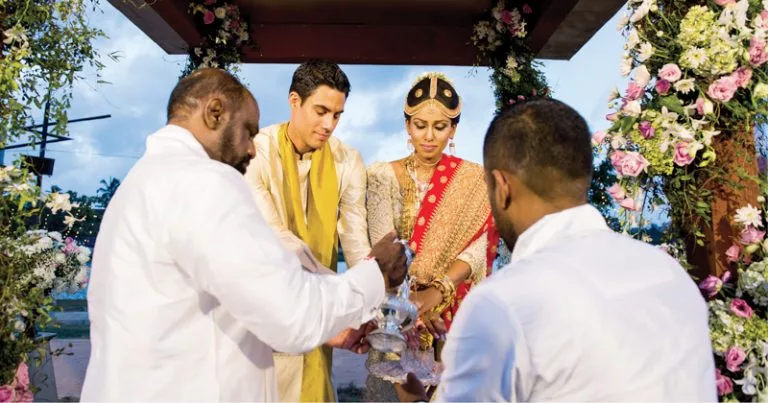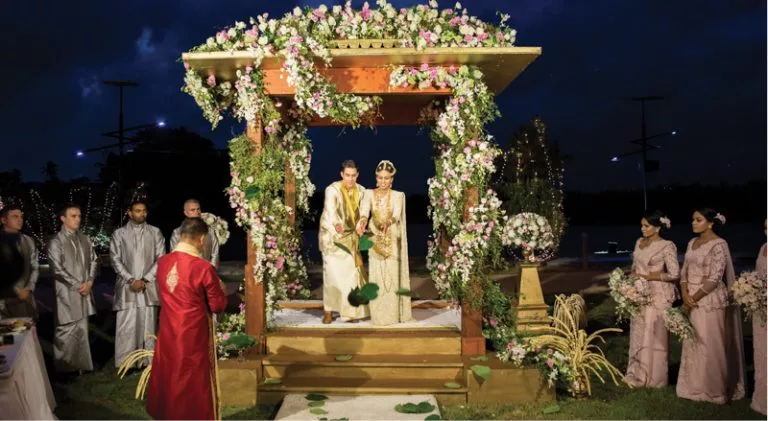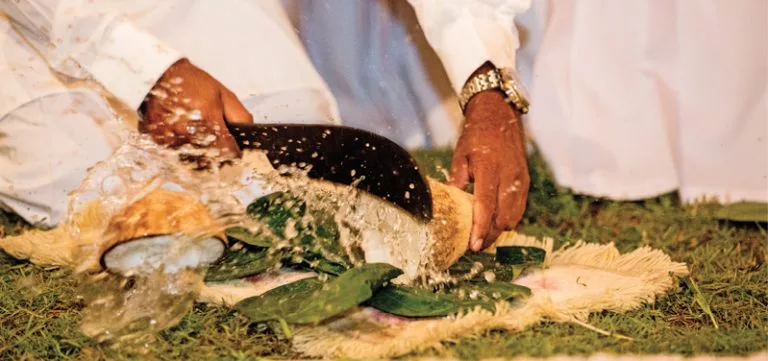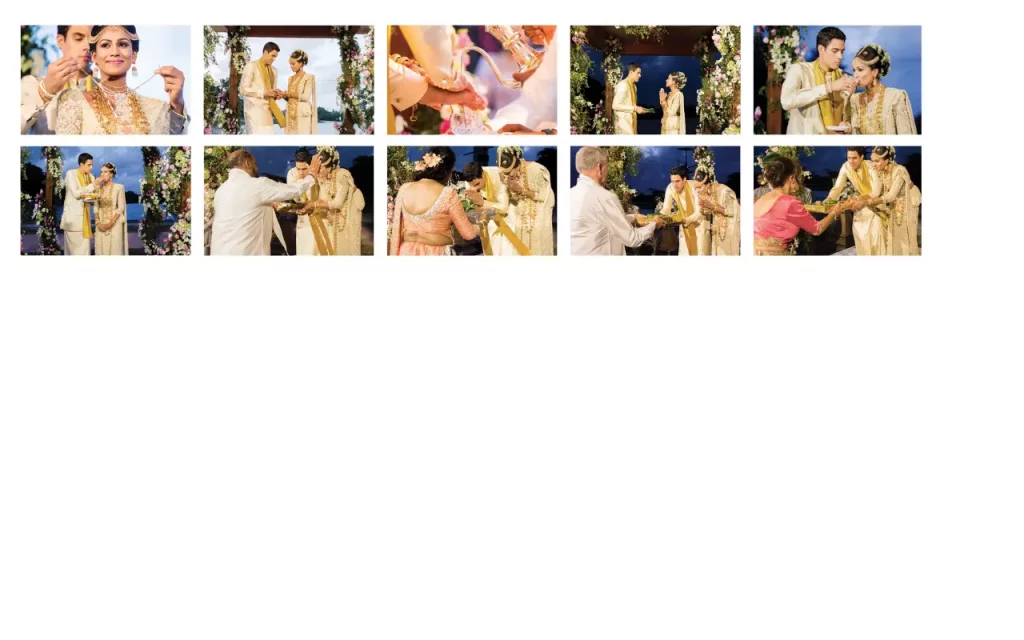
The beautiful bride draped in an exquisite ivory Osariya, adorned with the traditional Kandyan jewellery, and the handsome groom in Arya Sinhala attire step on to the Poruwa at the auspicious time. Thus signifying the beginning of the sacred ceremony of a Sri Lankan Buddhist wedding. It is an ancient practice that dates back to the time of the marriage of Prince Siddartha and Princess Yashodhara.
Words Udeshi Amarasinghe

The Poruwa or the marriage altar is an elegantly adorned structure that is elevated from the ground. It is generally made of wood with four pillars and has an uduwiyana (roof), flowers and traditional motifs are used for its decoration. The assembling of the Poruwa is commenced at an auspicious time. This is the most spiritual place of the wedding as blessings are bestowed on the couple by worshipping to the noble triple gems and divine gods. Therefore, great thought and care are taken when making the Poruwa.
It is believed that the Poruwa that we see today is made in the same tradition as the one built for the wedding of Prince Siddartha and Princess Yashodhara by the Satharavaram Deviwaru (the four main deities). It is for this reason that four punkalas (pots of prosperity) filled with coconut flowers are placed at the corners of the Poruwa. The coconut fronds signify prosperity. Then, betel leaves are kept at the four corners together with clay lamps and a few coin offerings. The betel leaves act as a natural cleanser while clay lamps are lit to seek the blessings of the deities.
In the same manner, fresh and healthy coconuts are kept to signify the four noble truths of Buddhism (suffering, the cause of suffering, ending suffering and the path taken to end suffering) and that the new couple have an understanding of the noble truths. Furthermore, nine sets of three betel leaves each are placed to seek the protection of the Navagraha (nine planets). Coins are placed on the Poruwa to indicate that the couple will not focus their lives on seeking wealth.
At the auspicious time the bride will step on from the left of the Poruwa while the groom steps on from the right. The families and retinue stand on either side during the ceremony where rituals that have deep meaning are performed to evoke blessings and strengthen this divine bond. The traditions and rituals of the Poruwa ceremony are performed by the Ashtaka, a layman who is well versed in the customs.
There are many steps in the ceremony, which reflect the manner that the young couple should lead their married life. Red rice and other grains are placed on the Poruwa in the shape of a square to signify that they are bound to family life. This also signifies that the couple will have sufficient food for their sustenance.
There are many steps in the ceremony, which reflect the manner that the young couple should lead their married life. Red rice and other grains are placed on the Poruwa in the shape of a square to signify that they are bound to family life.
The couple will seek the blessings of Goddess Pattini by offering seven sheaths of betel with coins. The couple also perform a sequence of exchanging betel leaves and then dropping the same on to the floor, this is said to dispel any negative energies and also to seek the blessings of the Bumi Devathava (the protector of the land) and Mahi Kanthawa (Mother Earth).
Rings are exchanged to represent the bond between husband and wife. Furthermore, to signify that the groom will take care of his bride, a necklace is gifted to her as well as a saree, (which is generally worn for the home-coming). The groom will feed sweetmeats and a glass of milk to the bride as well.

The actual ceremony that signifies the union of the bride and groom is when the two little fingers (pinky) of the couple are tied together with a pirith noola (blessed thread) or golden thread and pirith pan (blessed water) is poured on this thread by the bride’s father or uncle. The Ashtaka chants the verses of the Gatha (prayer) Bhavathu Sabba Mangalam at this time. Generally, when the water is poured on the thread it tightens signifying the strength of the bond.
This ritual too is believed to be from the wedding ceremony of Prince Siddartha and Princess Yashodhara, where God Shakra had poured water on their fingers tied with a golden thread.
The Jayamangala Gatha is recited by a group of young girls to evoke blessings and also ensure the spiritual awareness of the young couple.
The mother of the bride is generally presented with the kiri kachchiya (a white cotton cloth) by the groom, atop a heppuwa (tazza) laden with betel leaves, a giraya (areca nut cutter) and the thread that was used to tie the two fingers. This is done to show the couple’s gratitude to the bride’s mother for raising a lovely woman. The white cloth depicts the child being nourished by a mother’s milk. The mother of the bride will then walk backwards with the heppuwa and the white cloth held above her head. This is to show mutual respect to each other.
The customary seven-piece Kandyan necklace set was made completely of gold and precious gems. Blessings were bestowed upon the necklace set at the Temple of the Tooth Relic and the Hathara Devala (Vishnu, Natha, Kataragama and Pattini) in Kandy.
Gifts are then given to the father of the bride as well as the parents of the groom. This is performed with a sheath of betel, which signifies respect and gratitude towards their parents.

Once all the rituals are completed permission has to be sought from Mother Earth to step down from the Poruwa. The newly wedded couple are held by the uncle and slowly guided as they step down from the Poruwa. At the same time a coconut atop betel leave with a lit camphor is split into two to cast away any misfortune and to bring good faith and blessings to the newly wedded couple.
The moment that the couple step-off the elevated pavilion and on to the ground amidst the beat of traditional drums at an auspicious time is the moment that they have become husband and wife.
In the present day many customs and rituals that are performed on the Poruwa vary and the sequence may differ as well. The duration on which the bride and groom will be on the Poruwa depends on the auspicious times that they have to get on and get-off the Poruwa.
There are many traditions and rituals in the Poruwa ceremony, which are beautiful to watch. It is a ceremony that epitomises Sri Lankan culture and heritage, and the beauty of beginning a new stage in life…

Thank you to Chamithrie and Nicholas Cornish for providing us with the information and photographs of their wedding day.



